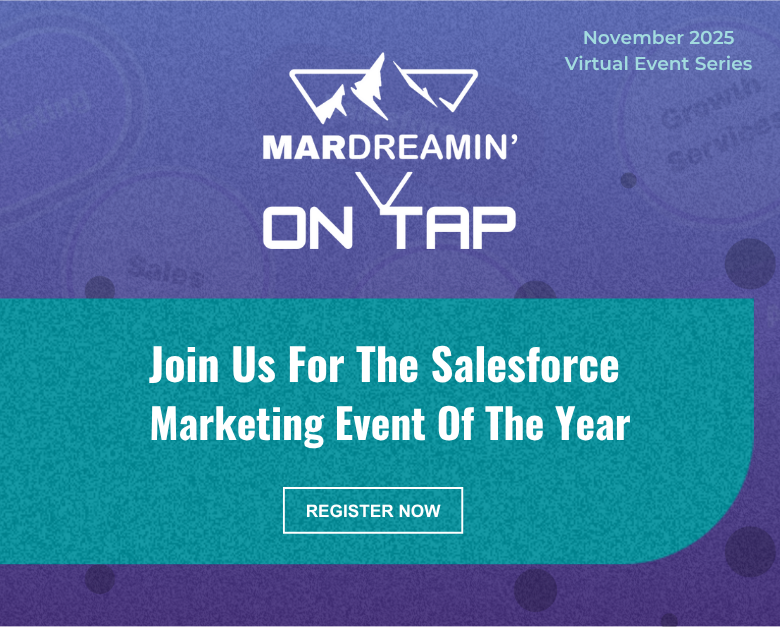Salesforce Marketing Cloud Engagement has so many complex ways to create personalized experiences for the audiences the platform touches.
And if you haven’t gathered from the title, Salesforce Marketing Cloud Personalization (formerly Interaction Studio… RIP Interaction Studio) is a great way to level up your personalization game. This is for the pros who have long since mastered things like personalization strings, dynamic content, and even AMPscript in the platform.
However, as with many Marketing Cloud features, Marketing Cloud Personalization offers so much flexibility and configurability that it can be challenging to know just where and how to begin.
Three Marketing Cloud Personalization Use Case Examples
Perhaps the best way to get started is to understand some industry-specific use cases for when Marketing Cloud Personalization web and mobile personalized campaigns can be strategically leveraged to create a customized, unified, and value-driven experience for your customers at every stage of the life cycle.
Use Case #1: Serve targeted educational content for prospective customers in the finance industry
A financial advisory company knows that potential new customers frequently conduct more research in the earliest stages of the buying lifecycle. Fortunately, the company maintains a finance blog on their site that features thought leadership from their advisors for just this very purpose.
When a new customer first comes to the company’s site, they may see an assortment of featured blog posts on the home page. Some posts on mutual fund investments capture their interest, so they click into them. They may then use the navigation menu or site search to investigate further.
Tracking content engagement
Meanwhile, Marketing Cloud Personalization tracks their site activity, such as which blog posts and product pages they spend more time on. They use this information to build a profile of customer preferences and affinities. Then, surface content in which the customer has indicated an interest using this customer profile information.
Showing profile-specific content
The next time the customer navigates to the home page or the blog landing page, they see featured posts on best tips to diversify their funds and an explainer of what investment objectives, risks, charges, and expenses they should be aware of when selecting a mutual fund. The customer clicks into the posts and successfully becomes further engaged with the company’s website.
Use Case #2: Enrich a student’s higher education on-campus experience.
With tuition more expensive than ever and the pool of college students ever shrinking, a regional college knows that one of the strongest differentiators they can offer their students is a rewarding college experience that isn’t just confined to the classroom.
Showing targeted reminders in the college online portal
When a student subscribes to a college campus group’s mailing list, Marketing Cloud Personalization tracks that activity. The tool displays reminders of upcoming meetings hosted by that group on the home page of the student’s online portal account.
And, Marketing Cloud Personalization highlights a promotion for an upcoming lecture hosted by a notable product designer when the student browses the college’s events calendar. That’s because the system knows the student once took an elective on product design.
After class, the student stops by a local art gallery that features art from fellow college students. Marketing Cloud Personalization notes the geolocation and time spent within the store. It uses that information to display a 15% discount code for the gallery in an infobar banner ad within the college’s mobile app. The student also sees an ad for the store when they get the monthly campus newsletter they subscribed to.
Enhancing the overall student experience
By being served content that is tailored to the student’s own personal and educational interests, the student is more connected with their campus and, as a result, their satisfaction with their college experience increases.
Use Case #3: Onboard new app users with well-timed contextual tips and cross-sell to existing customers in the same place, at the same time.
New users logging into a company’s app for the first time may need initial guidance on how to use the app to encourage adoption. But there also needs to be a balance between providing timely instruction and not being obstructive.
Marketing Cloud Personalization first designates which users are logging into their accounts for the first time and those who have already been using the app extensively into two audiences.
Automate first-time user adoption
When a first-time user logs onto the app, they receive a pop-up window offering them a brief tutorial on how to use the app, with the option to entirely skip or end the tutorial at any time. The tutorial displays step-by-step contextual pop-ups at different places on the screen to demonstrate the app’s functionality and features. The tutorial finishes by pointing out to the user where they can access the support center for future assistance. If the user skipped the tutorial or exited out of it early, Marketing Cloud Personalization can note this.
Ensure continued use over time
Marketing Cloud Personalization can then monitor these new users for a defined period of time to evaluate whether they are using the app, and place them on a journey within Journey Builder to issue reminders and feature highlights. Once a user becomes comfortable in using the app, they can be moved from the first-time user audience and into other segments for further targeted marketing.
Create deeper connections over time
For the audience of existing users, Marketing Cloud Personalization can display inline banner promotions for other products they may be interested in or useful tips on how to use the product that they bought based on their actions, how long they’ve been a customer, and their personal attributes, all within the app, on the company website, and in marketing emails and text messages.
While targeting two different audience segments, Marketing Cloud Personalization can display content not only based on customer activity, but also at strategic moments and through different statuses, such as whether they’re a first-time user or not. Customers, in turn, not only receive personalized content, but content that is served to them at the time they would benefit from it the most.
Three Things to Prepare Before SFMC Personalization Implementation
The above examples are hardly an exhaustive list of all the ways in which companies can engage potential, new, and existing customers with Marketing Cloud Personalization. But no matter the industry or use case, there are also three things you should do to set your company up for success long before you implement.
Step 1. Align Internal Teams
You need to align your internal teams. The lift for setting up Marketing Cloud Personalization is quite a bit heavier than many of Marketing Cloud’s other tools. Depending on your business needs, the tool will require more resources of varying specializations.
- You’ll need web development resources for deploying the necessary code to your website and apps (and the more frequently your site changes, the greater the demand on your web development team).
- Your marketing and graphic design teams will need to create all the variations of content and assets that could be displayed to your audiences.
- It is also highly recommended that you invest in UX Design resources as well, because…
Step 2. Know Your Audience
You need to know your customers. Not only should you identify all potential customer personas, but you should also map the journeys each persona could have across your website or app, whether it’s a first-time visitor browsing your site or a long-standing customer who wants to change the billing information associated with their account.
Identify customer interaction points
This process involves identifying every point of customer interaction, including areas where your customer is likely to experience frustration and reward (there’s a reason, after all, that Marketing Cloud Personalization is called a Real-Time Interaction Management platform).
A good UX designer will conduct research and testing to accurately paint a full picture of how customers use your website or app. From there, you will be able to create a strategy for how Marketing Cloud Personalization will display the right messages in the right ways at the right time to deliver the highest value for your customers.
Step 3. Create Content Beforehand
You must frontload your content. Of course, with all that pre-planning and journey mapping means you’ll actually have to create the content you’ll be using for every personalized path your strategy involves.
Determine content categories and tags
You will also need to make sure your content is properly categorized and tagged for the audiences and customer interaction points with which they’ll be associated, and this is even more crucial.
For example, you want to feature other recommended products (let’s say, a moisture-resistant jacket, water bottle, and thermal socks) that are related to the product that a customer is viewing on your website (hiking boots).
You’ll need to decide on the content tags that determine what other related products to display (hiking, moisture resistance, outdoors) and for what type of audience segment attributes (new and returning customers, hikers, outdoor enthusiasts, beginner to intermediate experience, ages 20-45).
Completing Marketing Cloud Personalization implementation pre-work is totally worth it
While the amount of pre-work required to leverage Marketing Cloud Personalization can seem daunting all on its own, it’s important to remember that a hyper-personalization system requires a hyper-detailed amount of content to feed into it.
And all that work is likely to pay significant dividends in the end. According to a McKinsey & Company report, over three-quarters of consumers report that personalized communications are a key factor in brand considerations and increase the likelihood of repurchase.
When implemented (and maintained) correctly with the right personalization strategy in place, Marketing Cloud Personalization can give your company a powerful tool to sharpen your communications and truly engage with the full breadth and depth of your customers.
Ready to learn more about Marketing Cloud?
Sign up for our six-week virtual Salesforce Marketing Cloud Admin Bootcamp.
More Resources on Marketing Cloud Personalization:










